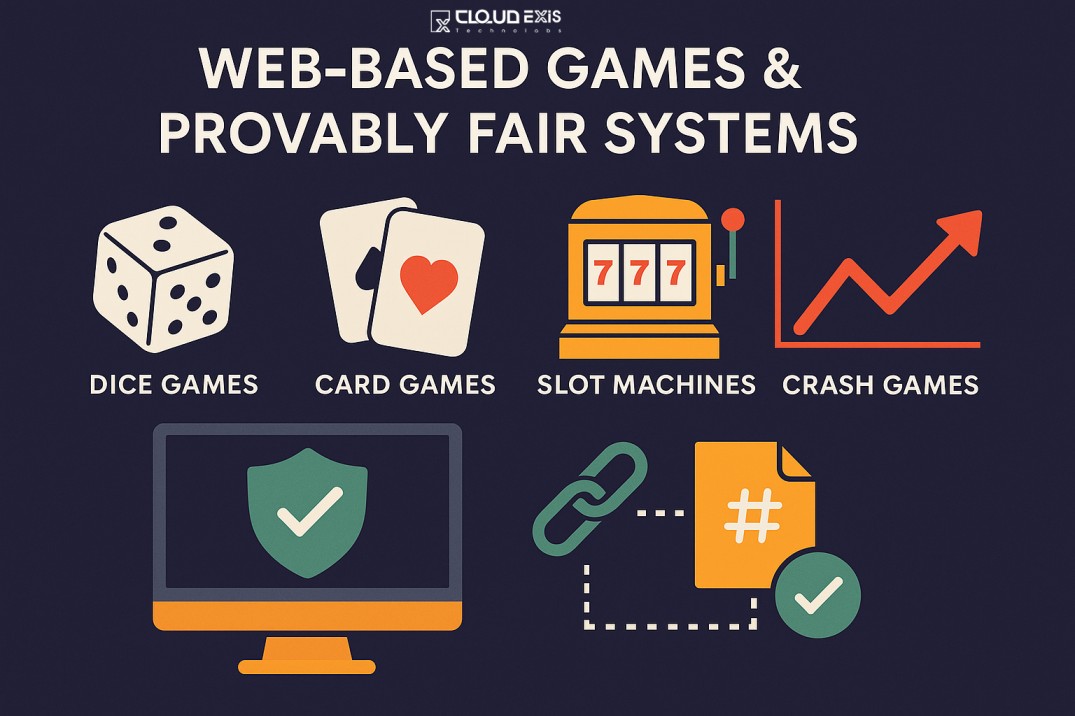In the world of online gaming, trust is everything. Whether you’re spinning a digital roulette wheel, playing a hand of poker, or rolling dice, the outcome must feel fair—or players simply won’t return. That’s where “provably fair” technology comes in, revolutionizing the landscape of web-based games by introducing transparency and verifiable randomness.
In this blog, we’ll dive deep into:
What “provably fair” means
Why it matters for online games
How it works under the hood
The top benefits for players and developers
Use cases in real-world web-based games
Challenges and considerations
Future trends in fair gaming
What Does “Provably Fair” Mean?
“Provably fair” is a cryptographic system used in online gaming platforms to verify that the outcome of a game was not manipulated. It ensures that neither the player nor the operator can know or influence the result in advance. Most provably fair games use cryptographic hash functions and random number generation to create a transparent, tamper-proof system.
This concept emerged from blockchain and crypto gambling communities but is now being adopted by mainstream web-based games due to its reliability and transparency.
Why Fairness in Web-Based Gaming Is Non-Negotiable
The online gaming industry is booming—with billions of dollars in revenue flowing through casinos, strategy games, and betting platforms every year. But this growth also brings heightened scrutiny and skepticism.
Key concerns players face:
Are the games rigged?
Does the house have too much advantage?
Are outcomes truly random?
In traditional centralized systems, players have no way to verify what happens behind the scenes. Provably fair technology changes that—making game outcomes verifiable, transparent, and above all, trustworthy.
How Does Provably Fair Gaming Work?
Let’s break it down step-by-step.
1. Seed Generation
A game uses two seeds:
Server Seed (generated by the game server)
Client Seed (provided by the player’s browser or input)
The server seed is typically hashed and sent to the user before the game starts—this way, the platform cannot change it afterward.
2. Player Interaction
The player either:
Generates their own seed
Accepts a browser-generated seed
This adds unpredictability to the result.
3. Result Calculation
The final outcome (e.g., dice roll, card drawn) is calculated using a combination of:
Result = Hash(Server Seed + Client Seed + Nonce)
The nonce is a number that increases with every new game to ensure uniqueness.
4. Verification
After the round, the player can:
See the unhashed server seed
Use the formula and hashing function to verify the result
Popular tools and browser extensions are available to help players run these checks independently.
Key Benefits of Provably Fair Web-Based Games
✅ 1. Transparency Builds Trust
Players know that game operators cannot manipulate outcomes post-facto. This is a huge leap for platforms trying to stand out in competitive markets.
✅ 2. Decentralization-Ready
Provably fair games naturally align with decentralized applications (dApps) and crypto platforms. They don’t require third-party verification.
✅ 3. Increased Player Retention
Fairness isn’t just ethical—it’s profitable. Platforms that prove integrity tend to retain users longer and attract high-value players.
✅ 4. Brand Reputation & SEO Value
Transparency adds to your brand’s credibility, and blogs that explain your provably fair system help you gain organic traffic and SEO juice.
✅ 5. Regulatory Alignment
As governments begin to scrutinize online gambling and gaming more, having verifiable fairness can help platforms meet compliance and licensing requirements.
Examples of Provably Fair Web Games in Action
Here are a few well-known types of games using provably fair mechanics:
🎲 Dice Games
Players choose a number range, and a provably fair algorithm rolls a virtual dice. Examples: Stake, Primedice.
🃏 Card Games
Card shuffles are verifiable. Hashing ensures decks aren’t stacked or manipulated mid-game.
🎰 Slot Machines
Each spin’s result is generated through a client-server seed and can be re-verified post-spin.
💣 Crash Games
These games involve real-time multipliers and rely on provably fair logic to determine when the “crash” happens.
🔮 Blockchain-Based Lottery
Players can verify if a random draw was genuinely random, based on server + blockchain input.
Should You Integrate Provably Fair Logic in Your Game?
If you’re building a web-based game, integrating a provably fair system is a powerful feature—especially if your game includes:
Monetary incentives (prizes, tokens, NFTs)
Player-vs-player outcomes
Real-time randomness
Any element of chance
🔧 Tech Stack Compatibility
Provably fair games are typically built using:
Frontend: React.js / Vue.js
Backend: Node.js / Laravel / Python Flask
Hashing Algorithms: SHA-256 / HMAC-SHA512
Blockchain Oracles (Optional): Chainlink, Provable, Random.org APIs
Common Concerns & Limitations
Despite the advantages, provably fair gaming isn’t without challenges.
⚠️ Complexity for New Players
Many users may not know how to verify fairness. A simple UI and helpful guides are essential.
⚠️ Backend Transparency Is Crucial
If you don’t reveal your server seed (even hashed), players will doubt the process.
⚠️ Not Foolproof Without Secure Hosting
Even provably fair systems can be compromised if your backend is insecure or manipulated after seed generation.
⚠️ Doesn’t Solve Everything
Provably fair systems verify randomness—not gameplay fairness, payout ratios, or terms & conditions.
Future Trends: Provably Fair + Web3 + AI
The future of web-based games will likely combine provably fair logic with:
🔗 Blockchain Smart Contracts
Game logic and random generation on-chain reduce reliance on centralized servers.
🤖 AI Game Moderation
AI systems can auto-flag suspicious behavior or unfair tactics.
🧩 NFT Integration
Fair random drops for NFT collectibles are becoming popular in P2E (Play-to-Earn) ecosystems.
🌍 Cross-Platform Fairness
Shared seeds or blockchain timestamps could let mobile, desktop, and VR platforms share fair gameplay experiences.
Final Thoughts: Why It Matters Now More Than Ever
In a digital-first gaming world where players often never meet game operators in person, trust must be earned through transparency, not promises. Provably fair systems do just that.
Whether you’re building a casino game, gamified app, or full-blown Web3 platform, integrating provably fair logic isn’t just a smart move—it’s becoming a standard. As players get savvier, they’ll demand games that aren’t just fun—but also fair.
So if you’re launching a new web-based game or revamping an existing one, now’s the time to consider a provably fair architecture. Your users—and your brand reputation—will thank you.
Ready to Build a Provably Fair Game?
At Cloudexis Technolabs, we’ve helped startups and gaming platforms integrate provably fair systems using cutting-edge technologies like Laravel, React.js, Node.js, and blockchain integrations. Whether you’re building a simple dice game or a complex multiplayer platform, we’re here to ensure it’s provably fair, scalable, and secure.
📩 Reach out to us for a free consultation or portfolio demo.






